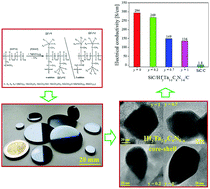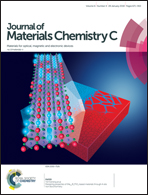SiC/HfyTa1−yCxN1−x/C ceramic nanocomposites with HfyTa1−yCxN1−x-carbon core–shell nanostructure and the influence of the carbon-shell thickness on electrical properties†
Abstract
Dense monolithic SiC/HfyTa1−yCxN1−x/C (y = 0, 0.2 and 0.7) ceramic nanocomposites were prepared upon spark plasma sintering of amorphous SiHfTaC(N) ceramic powders which were synthesized from single-source-precursors. The microstructural evolution of the ceramic powders was investigated using elemental analysis, X-ray diffraction, Raman spectroscopy and transmission electron microscopy (TEM). The results reveal that the powdered and dense monoliths of SiC/HfyTa1−yCxN1−x/C ceramic nanocomposites annealed at T ≥ 1700 °C and at 2200 °C, respectively, are characterized by the presence of a homogeneous dispersion of HfyTa1−yCxN1−x-carbon core–shell nanoparticles within a β-SiC matrix. Hf/Ta atomic ratios (or y values) of the in situ generated HfyTa1−yCxN1−x-carbon core–shell nanoparticles can be controlled precisely by molecular tailoring of the preceramic precursors, which further tunes the thickness of the in situ formed carbon shell. Interestingly, with increasing the value y the thickness of the carbon shell increases, while the electrical conductivity of the dense monolithic SiC/HfyTa1−yCxN1−x/C (y = 0, 0.2 and 0.7) nanocomposites significantly reduces. The unique HfyTa1−yCxN1−x-carbon core–shell nanostructure opens a new strategy towards tailoring the electrical conductivity of SiC/HfyTa1−yCxN1−x/C nanocomposites for potential electromagnetic applications in harsh environments.



 Please wait while we load your content...
Please wait while we load your content...